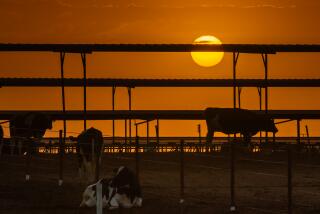One Mad Cow Can’t Stop This Show
- Share via
DENVER — Declining cattle prices and the mad cow scare weren’t dampening the enthusiasm -- or number of anticipated entries -- as the National Western Stock Show opened its 98th edition Saturday.
About 15,000 animals from at least 40 states were to be shown or sold during the 16-day event, one of the country’s largest and most prestigious showcases for livestock producers. Crowds were expected to rival last year’s 641,000 visitors.
The show offered a perfect forum to educate the public and update ranchers about mad cow disease, as well as the safety of the U.S. food system, said Pat Grant, stock show president.
Session topics included mad cow disease and efforts to track cattle from birth to slaughterhouse, a significant issue as authorities try to track the history of a Washington cow infected with the disease.
Authorities also were going to electronically monitor mandatory certificates proving show animals were disease-free.
“This is a wonderful opportunity to bring together a lot of people who have been significantly impacted by the identification of the one Holstein cow up in Washington state,” Grant said.
The annual event features livestock exhibits and sales, horse shows and the country’s fourth-largest rodeo in terms of prize money. It generates an estimated $80 million for the Denver-area.
Mad cow disease, or bovine spongiform encephalopathy, is blamed on contaminated feed. The disease is a concern because humans can develop variant Creutzfeldt-Jakob disease from eating beef products contaminated with tissue from the brain, spinal cord or small intestine of infected cows.
The country’s first known case of mad cow disease was diagnosed Dec. 23 in a cow imported to the United States from Canada, whose beef industry suffered after the discovery of an infected cow in May.
Grant said the mad cow scare would have no affect on the show, noting that crowds were expected to be at least as large as those at last year’s event. Early ticket sales for various events show interest was high, he said.
The public understands that unlike foot-and-mouth disease, a concern in 2002 after an outbreak in Europe, mad cow isn’t contagious, Grant said.
Rancher John Lockie of Billings, Mont., said he expected good participation.
“People from this part of the world are going right for it and planning on taking their cattle down,” said Lockie, executive director of R-CALF USA United Stock Growers of America. The trade group planned its national convention in Denver to coincide with the stock show.
John Stencel, president of the Denver-based Rocky Mountain Farmers Union, was expecting participants from throughout the world. “The stock show is the best time for agriculture to put its best foot forward,” he said.
Because of a U.S. ban on Canadian cattle, Canadian ranchers were unable to exhibit livestock at the show, although they were expected to attend and participate in purchases.
Only about 100 of the several thousand cattle at the show typically come from Canada, livestock manager James Goodrich said.
This year’s rodeo prize money was $520,000. Stock show spokeswoman Kati Christensen said there was a new system in which the top-ranked cowboys automatically qualify and others have to compete to earn a chance to perform.
“It will allow us to shorten the performances, and there will be competitors that everyone recognizes,” Christensen said.
The horse shows included “An Evening of Dancing Horses,” accompanied by the Pueblo Symphony Orchestra.
More to Read
Sign up for Essential California
The most important California stories and recommendations in your inbox every morning.
You may occasionally receive promotional content from the Los Angeles Times.










